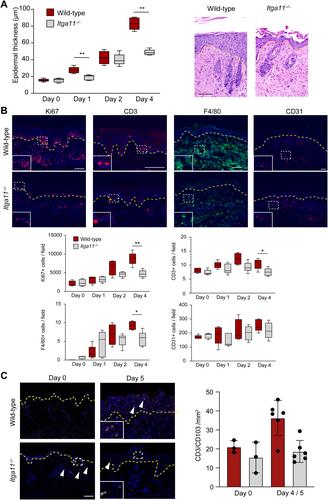下载PDF
{"title":"正向遗传学和功能分析表明Itga11是小鼠银屑病样皮炎的调节剂","authors":"Katja Bieber, Siegfried Bezdek, Yask Gupta, Artem Vorobyev, Tanya Sezin, Natalie Gross, Jasper Prüssmann, Jean-Paul Sayegh, Mareike Becker, Sadegh Mousavi, Ashref Hdnah, Sven Künzel, Saleh M Ibrahim, Ralf J Ludwig, Donald Gullberg, Christian D Sadik","doi":"10.1002/path.6162","DOIUrl":null,"url":null,"abstract":"<p>Psoriasis is a chronic inflammatory skin condition. Repeated epicutaneous application of Aldara® (imiquimod) cream results in psoriasiform dermatitis in mice. The Aldara®-induced psoriasiform dermatitis (AIPD) mouse model has been used to examine the pathogenesis of psoriasis. Here, we used a forward genetics approach in which we compared AIPD that developed in 13 different inbred mouse strains to identify genes and pathways that modulated disease severity. Among our primary results, we found that the severity of AIPD differed substantially between different strains of inbred mice and that these variations were associated with polymorphisms in <i>Itga11</i>. The <i>Itga11</i> gene encodes the integrin α11 subunit that heterodimerizes with the integrin β1 subunit to form integrin α11β1. Less information is available about the function of ITGA11 in skin inflammation; however, a role in the regulation of cutaneous wound healing, specifically the development of dermal fibrosis, has been described. Experiments performed with <i>Itga11</i> gene-deleted (<i>Itga11</i><sup><i>−/−</i></sup>) mice revealed that the integrin α11 subunit contributes substantially to the clinical phenotype as well as the histopathological and molecular findings associated with skin inflammation characteristic of AIPD. Although the skin transcriptomes of <i>Itga11</i><sup>−/−</sup> and WT mice do not differ from one another under physiological conditions, distinct transcriptomes emerge in these strains in response to the induction of AIPD. Most of the differentially expressed genes contributed to extracellular matrix organization, immune system, and metabolism of lipids pathways. Consistent with these findings, we detected a reduced number of fibroblasts and inflammatory cells, including macrophages, T cells, and tissue-resident memory T cells in skin samples from <i>Itga11</i><sup>−/−</sup> mice in response to AIPD induction. Collectively, our results reveal that <i>Itga11</i> plays a critical role in promoting skin inflammation in AIPD and thus might be targeted for the development of novel therapeutics for psoriasiform skin conditions. © 2023 The Authors. <i>The Journal of Pathology</i> published by John Wiley & Sons Ltd on behalf of The Pathological Society of Great Britain and Ireland.</p>","PeriodicalId":232,"journal":{"name":"The Journal of Pathology","volume":"261 2","pages":"184-197"},"PeriodicalIF":5.6000,"publicationDate":"2023-08-11","publicationTypes":"Journal Article","fieldsOfStudy":null,"isOpenAccess":false,"openAccessPdf":"https://onlinelibrary.wiley.com/doi/epdf/10.1002/path.6162","citationCount":"0","resultStr":"{\"title\":\"Forward genetics and functional analysis highlight Itga11 as a modulator of murine psoriasiform dermatitis\",\"authors\":\"Katja Bieber, Siegfried Bezdek, Yask Gupta, Artem Vorobyev, Tanya Sezin, Natalie Gross, Jasper Prüssmann, Jean-Paul Sayegh, Mareike Becker, Sadegh Mousavi, Ashref Hdnah, Sven Künzel, Saleh M Ibrahim, Ralf J Ludwig, Donald Gullberg, Christian D Sadik\",\"doi\":\"10.1002/path.6162\",\"DOIUrl\":null,\"url\":null,\"abstract\":\"<p>Psoriasis is a chronic inflammatory skin condition. Repeated epicutaneous application of Aldara® (imiquimod) cream results in psoriasiform dermatitis in mice. The Aldara®-induced psoriasiform dermatitis (AIPD) mouse model has been used to examine the pathogenesis of psoriasis. Here, we used a forward genetics approach in which we compared AIPD that developed in 13 different inbred mouse strains to identify genes and pathways that modulated disease severity. Among our primary results, we found that the severity of AIPD differed substantially between different strains of inbred mice and that these variations were associated with polymorphisms in <i>Itga11</i>. The <i>Itga11</i> gene encodes the integrin α11 subunit that heterodimerizes with the integrin β1 subunit to form integrin α11β1. Less information is available about the function of ITGA11 in skin inflammation; however, a role in the regulation of cutaneous wound healing, specifically the development of dermal fibrosis, has been described. Experiments performed with <i>Itga11</i> gene-deleted (<i>Itga11</i><sup><i>−/−</i></sup>) mice revealed that the integrin α11 subunit contributes substantially to the clinical phenotype as well as the histopathological and molecular findings associated with skin inflammation characteristic of AIPD. Although the skin transcriptomes of <i>Itga11</i><sup>−/−</sup> and WT mice do not differ from one another under physiological conditions, distinct transcriptomes emerge in these strains in response to the induction of AIPD. Most of the differentially expressed genes contributed to extracellular matrix organization, immune system, and metabolism of lipids pathways. Consistent with these findings, we detected a reduced number of fibroblasts and inflammatory cells, including macrophages, T cells, and tissue-resident memory T cells in skin samples from <i>Itga11</i><sup>−/−</sup> mice in response to AIPD induction. Collectively, our results reveal that <i>Itga11</i> plays a critical role in promoting skin inflammation in AIPD and thus might be targeted for the development of novel therapeutics for psoriasiform skin conditions. © 2023 The Authors. <i>The Journal of Pathology</i> published by John Wiley & Sons Ltd on behalf of The Pathological Society of Great Britain and Ireland.</p>\",\"PeriodicalId\":232,\"journal\":{\"name\":\"The Journal of Pathology\",\"volume\":\"261 2\",\"pages\":\"184-197\"},\"PeriodicalIF\":5.6000,\"publicationDate\":\"2023-08-11\",\"publicationTypes\":\"Journal Article\",\"fieldsOfStudy\":null,\"isOpenAccess\":false,\"openAccessPdf\":\"https://onlinelibrary.wiley.com/doi/epdf/10.1002/path.6162\",\"citationCount\":\"0\",\"resultStr\":null,\"platform\":\"Semanticscholar\",\"paperid\":null,\"PeriodicalName\":\"The Journal of Pathology\",\"FirstCategoryId\":\"3\",\"ListUrlMain\":\"https://onlinelibrary.wiley.com/doi/10.1002/path.6162\",\"RegionNum\":2,\"RegionCategory\":\"医学\",\"ArticlePicture\":[],\"TitleCN\":null,\"AbstractTextCN\":null,\"PMCID\":null,\"EPubDate\":\"\",\"PubModel\":\"\",\"JCR\":\"Q1\",\"JCRName\":\"ONCOLOGY\",\"Score\":null,\"Total\":0}","platform":"Semanticscholar","paperid":null,"PeriodicalName":"The Journal of Pathology","FirstCategoryId":"3","ListUrlMain":"https://onlinelibrary.wiley.com/doi/10.1002/path.6162","RegionNum":2,"RegionCategory":"医学","ArticlePicture":[],"TitleCN":null,"AbstractTextCN":null,"PMCID":null,"EPubDate":"","PubModel":"","JCR":"Q1","JCRName":"ONCOLOGY","Score":null,"Total":0}
引用次数: 0
引用
批量引用



